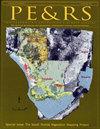基于随机森林回归的ICESat-2 ATLAS星载激光雷达散射衰减系数(Kd
IF 2
4区 地球科学
Q4 GEOGRAPHY, PHYSICAL
引用次数: 6
摘要
本研究利用美国国家航空航天局ICESat-2卫星上的绿波长激光雷达的数据,研究了一种测量水浊度的新方法,具体来说,就是测量下坡辐照度的扩散衰减系数Kd。该方法使我们能够填补现有Kd数据集的近岸数据空白,并提供比基于被动多光谱卫星图像的方法更直接的测量方法。此外,与其他基于激光雷达的方法相比,它不依赖于广泛的信号处理或系统脉冲响应函数的可用性,它被设计用于全球而不是特定的地理位置。该模型使用美国国家海洋和大气管理局可见光红外成像辐射计套件传感器在全球94个沿海地点测量的Kd值进行了测试,Kd值范围为0.05至3.6 m -1。结果证明了该方法的有效性,并可作为未来使用ICESat-2进行浊度机器学习回归研究的基准。本文章由计算机程序翻译,如有差异,请以英文原文为准。
Diffuse Attenuation Coefficient (Kd) from ICESat-2 ATLAS Spaceborne Lidar Using Random-Forest Regression
This study investigates a new method for measuring water turbidity—specifically, the diffuse attenuation coefficient of downwelling irradiance Kd —using data from a spaceborne, green-wavelength lidar aboard the National Aeronautics and Space Administration's ICESat-2
satellite. The method enables us to fill nearshore data voids in existing Kd data sets and provides a more direct measurement approach than methods based on passive multispectral satellite imagery. Furthermore, in contrast to other lidar-based methods, it does not rely on extensive signal
processing or the availability of the system impulse response function, and it is designed to be applied globally rather than at a specific geographic location. The model was tested using Kd measurements from the National Oceanic and Atmospheric Administration's Visible Infrared Imaging Radiometer
Suite sensor at 94 coastal sites spanning the globe, with Kd values ranging from 0.05 to 3.6 m –1 . The results demonstrate the efficacy of the approach and serve as a benchmark for future machine-learning regression studies of turbidity using ICESat-2.
求助全文
通过发布文献求助,成功后即可免费获取论文全文。
去求助
来源期刊

Photogrammetric Engineering and Remote Sensing
地学-成像科学与照相技术
CiteScore
1.70
自引率
15.40%
发文量
89
审稿时长
9 months
期刊介绍:
Photogrammetric Engineering & Remote Sensing commonly referred to as PE&RS, is the official journal of imaging and geospatial information science and technology. Included in the journal on a regular basis are highlight articles such as the popular columns “Grids & Datums” and “Mapping Matters” and peer reviewed technical papers.
We publish thousands of documents, reports, codes, and informational articles in and about the industries relating to Geospatial Sciences, Remote Sensing, Photogrammetry and other imaging sciences.
 求助内容:
求助内容: 应助结果提醒方式:
应助结果提醒方式:


